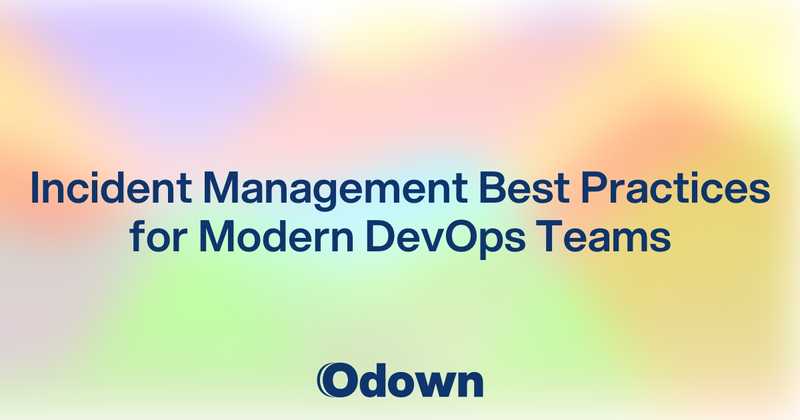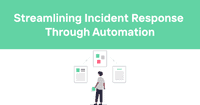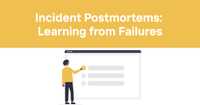Incident Management Best Practices for Modern DevOps Teams
Effective incident management transforms chaotic outages into structured problem-solving. When systems fail unexpectedly, the difference between minor disruption and major disaster often comes down to response procedures. Well-defined incident management processes reduce downtime, minimize business impact, and preserve customer trust even during challenging technical issues.
The most successful DevOps teams recognize that incidents are inevitable, but their impact is controllable. This mindset shift from "preventing all outages" to "expertly managing unavoidable incidents" creates resilient organizations that recover quickly and learn continuously. Implementing structured incident management practices equips teams to handle the unexpected with confidence and precision.
Building an Effective Incident Response Workflow
Incident management starts with a clear, repeatable response workflow:
Incident Detection and Triage
Detection Methods:
- Automated monitoring alerts
- User-reported issues
- Internal system warnings
- Performance threshold violations
Initial Assessment Questions:
- What services are impacted?
- How many users are affected?
- Is the issue spreading or contained?
- What business functions are disrupted?
- What's the estimated severity level?
Automated Incident Classification
Severity Levels:
- P1 (Critical): Complete service outage, significant revenue impact
- P2 (High): Major functionality broken, significant user impact
- P3 (Medium): Limited functionality issues, moderate user impact
- P4 (Low): Minor issues, minimal user impact
- P5 (Informational): No immediate impact, potential future concern
Classification Criteria Matrix:
| Impact Area | P1 | P2 | P3 | P4 | P5 |
|---|---|---|---|---|---|
| Revenue | >$X | >$Y | >$Z | <$Z | None |
| Users Affected | >50% | >25% | >10% | <5% | <1% |
| Core Functions | All | Major | Some | Minor | None |
| Data Integrity | High | Med. | Low | None | None |
| Reputation Risk | High | High | Med. | Low | None |
Escalation Procedures
Tiered Response Framework:
- First responder: Initial investigation and triage
- Service owner: Technical assessment and coordination
- Incident manager: Cross-team coordination
- Executive stakeholder: Business decision-making
Escalation Triggers:
- P1/P2 incidents automatically
- Resolution time exceeding SLA
- Technical expertise requirements
- Customer impact thresholds
- Regulatory or compliance concerns
On-Call Rotation Management
On-Call Structure:
- Primary and secondary responders
- Specialized expertise scheduling
- Follow-the-sun coverage
- Escalation paths defined
- Handoff procedures documented
Responder Tools:
- Monitoring access from mobile devices
- Centralized documentation
- Investigation runbooks
- Communication templates
- Access management
Rotation Sustainability:
- Maximum on-call frequency limits
- Post-incident recovery time
- Knowledge sharing requirements
- Training for new team members
- Balanced coverage across timezones
When setting up monitoring for API response times, ensure your incident management system includes appropriate escalation paths based on performance degradation severity.
Communication Strategies During Outages
Clear communication during incidents is crucial for effective resolution:
Internal Communication Channels
Team Coordination:
- Dedicated incident chat channel
- Video bridge for critical incidents
- Regular status updates
- Clear incident commander role
- Explicit ownership assignments
Executive Updates:
- Concise impact summaries
- Business metrics affected
- Customer-facing implications
- ETA for resolution
- Resources required
Example Internal Communication Template: INCIDENT UPDATE: #INC-2023-42 TIME: 14:35 UTC STATUS: Investigating IMPACT: Payment processing system unavailable AFFECTED: All regions, ~15% of transactions failing ACTIONS: Database team investigating connection errors NEXT UPDATE: 15:00 UTC or significant developments
External Stakeholder Updates
Customer Communication:
- Status page updates
- Email notifications for critical services
- Social media acknowledgment (when public)
- Support team briefing
- Account manager notifications for VIP customers
Partner/Vendor Coordination:
- Service dependency notifications
- Integration status updates
- Resource allocation requests
- Escalation contact activation
- Recovery coordination
Transparent Status Updates:
- Acknowledge issue promptly
- Provide specific impact details
- Avoid technical jargon
- Set realistic expectations
- Update regularly, even without resolution
Incident Timeline Documentation
Chronological Documentation:
- Initial alert time and details
- Key investigation steps
- Major decision points
- Mitigation actions taken
- Resolution milestones
Timeline Entry Format: [TIMESTAMP] - [ACTOR] - [ACTION/OBSERVATION] - [RESULT]
Example: [15:23 UTC] - Database Team - Identified connection pool exhaustion - Increased limit by 50%
Documentation Tools:
- Collaborative incident documents
- Automated chat logging
- Timeline visualization tools
- Screen recording for complex issues
- Voice transcription for calls
Post-Incident Analysis and Continuous Improvement
Incident response doesn't end with resolution—analysis drives improvement:
Conducting Effective Postmortems
Blameless Postmortem Principles:
- Focus on systems, not individuals
- Identify contributing factors
- Analyze decision-making context
- Explore alternative outcomes
- Document learnings over blame
Key Questions:
- What happened? (timeline)
- Why did it happen? (root causes)
- How did we respond? (effectiveness)
- What was the impact? (measurement)
- How can we prevent recurrence? (improvements)
Postmortem Template Structure:
- Incident Summary
- Brief description
- Duration and impact
- Services affected
- Timeline
- Detection
- Response actions
- Resolution steps
- Root Cause Analysis
- Technical factors
- Process factors
- Environmental factors
- Impact Assessment
- Customer impact
- Business metrics
- Reputation effects
- Corrective Actions
- Immediate fixes
- Long-term improvements
- Process changes
- Lessons Learned
- What went well
- What could improve
- Knowledge gaps identified
Tracking Incident Metrics
Key Performance Indicators:
- MTTD (Mean Time to Detect): How quickly incidents are discovered
- MTTI (Mean Time to Identify): How quickly root causes are determined
- MTTR (Mean Time to Resolve): Total incident duration
- MTBF (Mean Time Between Failures): Service reliability
- Customer Impact Minutes: Business impact measurement
Trend Analysis:
- Recurring incident patterns
- Common failure modes
- Response effectiveness metrics
- Resolution time trends
- Impact severity patterns
Visualization Approaches: KPI Dashboard Components Monthly incident volume by severity Average resolution time by type Customer impact minutes trend Top 5 incident root causes Service reliability heat map Team response performance
Implementing Improvements
Action Item Tracking:
- Specific, measurable improvements
- Clear ownership assignment
- Realistic timeframes
- Verification criteria
- Implementation prioritization
Common Improvement Categories:
- Monitoring enhancements
- Automated recovery procedures
- Dependency reduction
- Documentation improvements
- Training and simulation
Continuous Learning Loop:
- Regular incident review sessions
- Quarterly trend analysis
- Simulated incident exercises
- Knowledge sharing forums
- Process refinement workshops
Incident Management Tools and Integration
The right tools streamline incident management processes:
Comprehensive Incident Management Platform
Core Capabilities:
- Centralized incident tracking
- Automated notification routing
- Documentation templates
- Timeline visualization
- Metrics and reporting
Integration Requirements:
- Monitoring system connections
- Communication channel hooks
- Ticketing system synchronization
- Knowledge base linking
- Metrics dashboard feeds
Alert Integration and Notification Workflow
Alert Routing Logic:
- Service ownership mapping
- Time-of-day considerations
- Expertise matching
- Escalation automation
- Response verification
Response Orchestration:
- Automated diagnostics
- Playbook triggering
- Resource allocation
- Status update automation
- Recovery verification
Knowledge Management and Runbooks
Incident Knowledge Base:
- Service architecture documentation
- Common failure modes
- Diagnostic procedures
- Recovery steps
- Escalation contacts
Living Runbooks:
- Step-by-step procedures
- Decision trees for complex issues
- Access requirement documentation
- Verification checkpoints
- Recent incident references
Example Runbook Structure:
- DATABASE FAILURE RUNBOOK
- Verification Steps
- Check specific error messages
- Validate connectivity issues
- Confirm affected services
- Initial Response
- Check replication status
- Verify connection pools
- Check resource utilization
- Recovery Options
- Connection reset procedure
- Failover process
- Manual recovery steps
- Verification
- Service health checks
- Data integrity verification
- Performance validation
- Additional Resources
- Dashboard links
- Team contacts
- Vendor support information
Building a Learning Culture
Effective incident management requires more than tools and processes:
Team Training and Simulation
Training Program Elements:
- Incident response role training
- Technical investigation skills
- Communication protocols
- Decision-making frameworks
- Stress management techniques
Simulation Exercise Types:
- Tabletop scenarios
- Live fire exercises
- Surprise drills
- Cross-team coordination tests
- Major incident simulations
Psychological Safety and Blameless Culture
Cultural Principles:
- Reward transparency over concealment
- Celebrate learning from failure
- Focus on system improvement
- Encourage questioning and curiosity
- Share knowledge openly
Leadership Behaviors:
- Participate actively in postmortems
- Acknowledge system constraints
- Share personal learnings
- Focus on improvement over blame
- Provide resources for fixes
Collaborative Improvement Processes
Cross-Team Coordination:
- Regular incident review forums
- Shared postmortem library
- Common improvement tracking
- Joint simulation exercises
- Unified documentation standards
Knowledge Sharing Mechanisms:
- Incident database with search
- Lesson learned summaries
- New engineer onboarding materials
- Common failure mode catalog
- Resolution technique repository
Incident Management Maturity Model
Organizations evolve through predictable incident management stages:
Reactive (Level 1)
- Ad-hoc response to incidents
- Unclear roles and responsibilities
- Limited documentation
- Minimal post-incident review
- High stress during incidents
Defined (Level 2)
- Basic incident procedures documented
- Established severity definitions
- Simple on-call rotation
- Inconsistent postmortems
- Manual coordination and notification
Managed (Level 3)
- Standardized response workflows
- Consistent communication templates
- Regular postmortem practice
- Metric tracking and analysis
- Tool integration for key systems
Optimized (Level 4)
- Proactive incident detection
- Automated initial response
- Continuous improvement processes
- Advanced analytics and prediction
- Regular simulation training
Transformative (Level 5)
- Automated incident prevention
- Organization-wide learning culture
- Continuous procedure refinement
- Predictive incident analysis
- Industry-leading practices
Measuring Incident Management Success
Track these metrics to gauge effectiveness:
Primary Metrics
- MTTD (Mean Time to Detect): How quickly incidents are discovered
- MTTI (Mean Time to Identify): How quickly root causes are determined
- MTTR (Mean Time to Resolve): Total incident duration
- MTBF (Mean Time Between Failures): Service reliability
- Customer Impact Minutes: Business impact measurement
Secondary Indicators
- Repeat incident frequency
- Process adherence percentage
- Documentation quality ratings
- Team response satisfaction
- Knowledge utilization metrics
Creating effective incident management processes takes time, but pays significant dividends in reliability, customer satisfaction, and team confidence. By implementing these best practices, organizations transform chaotic outages into structured, efficient response operations.
Ready to implement effective incident management? Build structured processes and response workflows that transform outages from emergencies into manageable events.



